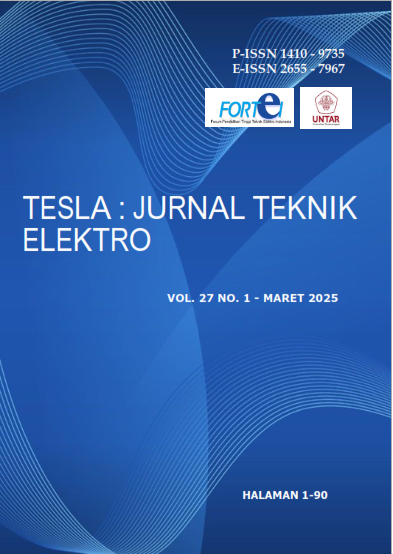REACTIVATION OF THE REMOTE CONTROLLED WEAPON STATION (RCWS) SYSTEM AS AN EMBEDDED SYSTEM-BASED DEFENSE TECHNOLOGY INNOVATION
Main Article Content
Abstract
Soldier safety in modern military operations demands weapons systems capable of safe and precise This study presents the reactivation of a previously non-functional Remote Controlled Weapon Station (RCWS) by implementing a Proportional Control (P-control) system using the Teensy 3.5 microcontroller to regulate motor movement on the azimuth and elevation axes. The RCWS system was developed using a distributed multi-microcontroller architecture, in which the Teensy 3.5 serves as the main controller connected to the Arduino Mega 2560 Pro for joystick management and the Arduino Nano for reading the 1024 PPR rotary encoder. The setpoint values were obtained from the joystick, while the actual position was measured by the rotary encoder to calculate the error and generate a proportional PWM control signal. Experimental results indicate that a larger error between the setpoint and actual position produces a higher PWM signal, enabling the system to deliver linear, stable, and precise motor responses. Furthermore, the implementation of limit control on the elevation axis (420 ≤ θ₂ ≤ 600) effectively prevents excessive movement and protects the mechanical structure. Overall, the reactivated RCWS operates in real-time with stable serial communication, and proven reliability, offering potential for further development through the integration of PID control, fuzzy logic, or computer vision tracking to enhance the performance of remote weapon control systems.
Abstrak
Keselamatan prajurit dalam operasi militer modern menuntut sistem persenjataan yang mampu beroperasi secara aman dan presisi. Penelitian ini membahas reaktivasi sistem Remote Controlled Weapon Station (RCWS) yang sebelumnya tidak berfungsi, dengan fokus pada penerapan kontrol proporsional (P-control) berbasis mikrokontroler Teensy 3.5 untuk mengatur pergerakan motor pada sumbu azimut dan elevasi. Sistem RCWS dirancang menggunakan arsitektur terdistribusi berbasis multi mikrokontroler, di mana Teensy 3.5 berperan sebagai pengendali utama yang terhubung dengan Arduino Mega 2560 Pro sebagai pengelola joystick dan Arduino Nano sebagai pembaca rotary encoder 1024 PPR. Nilai setpoint diperoleh dari joystick, sedangkan posisi aktual dibaca oleh rotary encoder untuk menghitung error dan menghasilkan sinyal kendali PWM secara proporsional. Hasil pengujian menunjukkan bahwa semakin besar error antara setpoint dan posisi aktual, semakin besar pula sinyal PWM yang dihasilkan, sehingga sistem mampu memberikan respon motor yang linier, stabil, dan presisi. Penerapan mekanisme limit control pada sumbu elevasi (420 ≤ θ₂ ≤ 600) berhasil mencegah pergerakan berlebih dan menjaga keamanan mekanik sistem. Secara keseluruhan, sistem RCWS yang direaktivasi berhasil beroperasi secara real-time dengan komunikasi serial yang stabil, serta dapat dikembangkan lebih lanjut menggunakan metode PID control, fuzzy logic, atau computer vision tracking untuk meningkatkan performa sistem kendali senjata jarak jauh
Article Details

This work is licensed under a Creative Commons Attribution-ShareAlike 4.0 International License.
This work is licensed under a TESLA: Jurnal Teknik Elektro Creative Commons Attribution-ShareAlike 4.0 International License. 
References
[1] I. Dehtiarov, P. Leontiev, D. Miroshnychenko, V. Lanchynskyi, and P. Buhaiets, “Design and Research of the Ground Robotic System Structure for Weapons Remote Control,” Eastern-European J. Enterp. Technol., vol. 6, no. 1(126), pp. 52–60, 2023, doi: 10.15587/1729-4061.2023.292432.
[2] M. Dorczuk, “Modern weapon systems equipped with stabilization systems: division, development objectives, and research problems,” Sci. J. Mil. Univ. L. Forces, vol. 197, no. 3, pp. 651–659, 2020, doi: 10.5604/01.3001.0014.3959.
[3] J. F. Dolasinki, “Remote Controlled Weapon Stations - Development of Thought and Technology,” Probl. Mechatronics Armament Aviat. Saf. Eng., vol. 11, no. 3, pp. 87–100, 2020, doi: 10.5604/01.3001.0014.3710.
[4] M. Svalstedt, “Modeling and Simulation of a Remote Controlled Weapon Station,” M.Sc. thesis, KTH Royal Institute of Technology, School of Engineering Sciences (SCI), TRITA-SCI-GRU; 2022:356, Stockholm, Sweden, 2022. Available: https://kth.diva-portal.org/smash/get/diva2%3A1752017/FULLTEXT01.pdf. Accessed: 28-Oct-2025.
[5] W. Lu, “Limit-protection method for the workspace of a parallel power head,” Strojniški vestnik – Journal of Mechanical Engineering, vol. 68, no. 10, pp. 560–570, 2022, doi: 10.5545/sv-jme.2022.69
[6] PJRC, “Teensy® 3.5 (Development Board) – Specifications,” PJRC. Available: https://www.pjrc.com/store/teensy35.html. Accessed: 23-Oct-2025.
[7] J. W. Simatupang, B. Prasetyo, and M. I. A. Galina, “Prototipe Mesin Penjual Air Mineral Otomatis berbasis Arduino Mega 2560 dan RFID-RC522,” ELKOMIKA, vol. 10, no. 2, pp. 484–499, 2022, doi: https://doi.org/10.26760/elkomika.v10i2.484
[8] RobotDyn, “MEGA 2560 PRO (Embed) CH340G/ATmega2560-16AU — Product Page,” RobotDyn. Available: https://robotdyn.com/mega-2560-pro-embed-ch340g-atmega2560-16au.html. Accessed: 27-Oct-2025.
[9] M. Dadić, P. Mostarac, R. Malarić, and J. Konjevod, “Digital compensation of a resistive voltage divider for power measurement,” Electron., vol. 10, no. 6, pp. 1–14, 2021, doi: 10.3390/electronics10060696.
[10] A. Abu Al-Hija’a, B. J. Szekeres, and M. Andó, “Comparative evaluation of voltage conversion and encoder pulse detection methods for controlling a model high-bay warehouse,” Discov. Appl. Sci., vol. 7, no. 2, 2025, doi: 10.1007/s42452-025-06523-2.
[11] J. Long, “Performance analysis of proportional feedback control and integral control in DC motors and speed control,” Theor. Nat. Sci., vol. 26, no. 1, pp. 81–88, 2023, doi: 10.54254/2753-8818/26/20241023.
[12] D. Mosconi, M. M. Silva, and A. A. G. Siqueira, “Optimal tuning of a proportional controller for DC motor position control via Fibonacci Search Method,” J. Mechatronics Eng., vol. 4, no. 1, pp. 12–21, 2021, doi: 10.21439/jme.v4i1.88.



